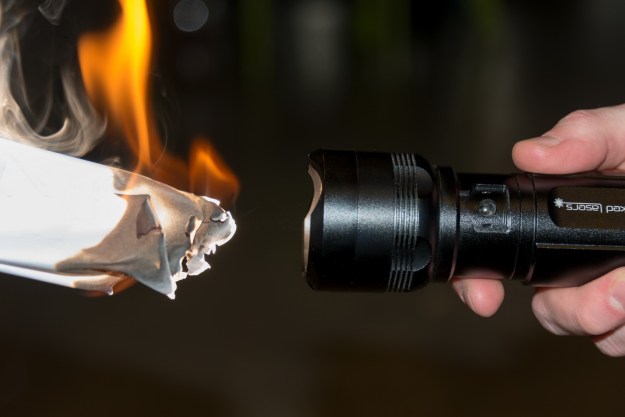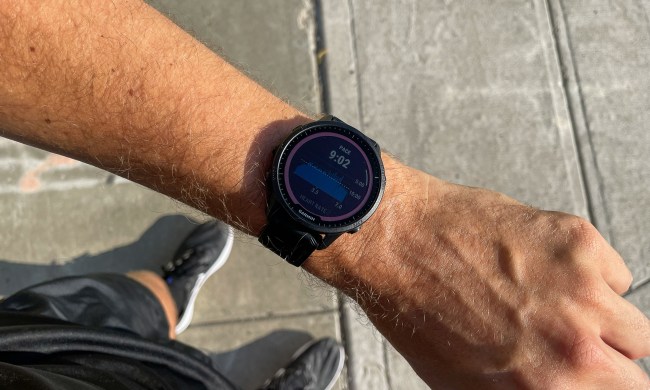
“The FlashTorch Mini does more than you'll ever need, but that's half the fun.”
- Durable build
- There's nothing else like it
- Absurdly bright
- Lights fires and cooks eggs
- Poor battery life
- Potential safety issues
- Price
When it comes to backpacking and camping, multipurpose tools are a great way to minimize the amount of gear you need to haul around. The FlashTorch Mini is touted as a 3-in-1 flashlight, stove, and torch. The device is a smaller version of the more powerful full-sized FlashTorch that produces 4100 lumens, regardless, the Mini still dishes out an absurd 2,300 lumens, which you’ll see is still more than capable of setting things ablaze.
With that much power, the FlashTorch Mini can certainly illuminate, but as rhetorically noted by the manufacturer: why merely illuminate when you can incinerate? That’s a hell of a sales pitch. Does the FlashTorch Mini deliver the overkill it promises? Perhaps more importantly, does anyone really need a lightsaber for a weekend getaway? Let’s find out.
The FlashTorch Mini is 8.6 inches long and 2.2 inches wide along the headlamp. It weighs 387 grams or just a little under a pound. This is mostly due to the rugged T6 aircraft-grade aluminum body. The unit arrives with a little assembly required. Before you can charge the device, you’ll need to unscrew the end cap and connect the battery. The FlashTorch Mini needs to charge for three hours before you can use it.
Flashlight
On paper and in the field, the FlashTorch Mini flashlight is flat out beastly. To put the 2,300 lumens in perspective, a regular 75-watt bulb produces about 1,100 lumens. Similarly, some of the most popular “ultra bright” flashlights on the market deliver a mere 300 lumens. This makes the FlashTorch Mini more of handheld floodlight than a traditional flashlight.
The unit has three power settings that cycle with the press of the LED button on the handle. The high power mode creates a massive field of clean, white light. This unfortunately drains the battery rather quickly, going from full to empty in about 30 minutes. Then again, you will rarely need such an intense light for a half hour at a time, if ever.
The unit becomes very hot while running at maximum power and it doesn’t take long before you quite literally feel the burn. You can easily singe yourself on the lens and the handle becomes almost too hot to hold. The aluminum casing simply acts as a heat conductor, but may be a necessity to dissipate the heat away from the battery.
There are some fairly intense warnings for using the device at full power and the product manual actually recommends wearing protective gloves when using the flashlight. Wicked Lasers also warns against aiming or pointing the FlashTorch Mini at yourself or others, noting that doing so could result in “temporary blindness or eye damage.” As anyone who has ever gone camping or hiking knows, inadvertently crossing a flashlight beam is nearly inevitable and such an advisory is a bit daunting to say the least.
It’s rare for a product this “As Seen On TV” to check out in a hands-on test.
At medium power the unit operates at 50 percent capacity. You are now working with a robust and still fairly unnecessary 1,150 lumens. Our tests determined this setting will drain the battery in about an hour. Thankfully, the body remains much cooler to the touch at this setting.
When set to Low Power, the FlashTorch Mini is functioning at 33 percent capacity. This mode is still more powerful than the vast majority of flashlights on the market. The wide, deep field of white light is more than enough to help you set up camp or illuminate a trail. It took about 90 minutes to drain the FlashTorch Mini at this power setting, making it ideal for short trips and nighttime tasks.
Stove
On the Wicked Lasers website, there’s a short video showing the FlashTorch Mini being used to scramble an egg. We were dubious to say the least, but the use of a halogen bulb as opposed to LED means that it’s entirely possible to fry an egg via the irradiative byproduct of luminescence.
To test this, we used a thin three-inch tin pan, an extra large egg, and a little milk. The flashlight must be set upright to be used as a stove and the bottom has a three-ridged platform designed specifically for this function.; the whole getup is a little janky. We sat the tin directly on headlamp, cracked the egg, and waited skeptically.
It didn’t take long for our reservations to be quelled. In less than 30 seconds, the egg was already steaming and popping. We simply whisked the egg with a fork as it cooked and in under eight minutes we had a perfectly cooked scrambled egg.
In general, the cooking time is on par with a regular camping stove, but you are using nearly a third of your battery life just to cook a single egg. So, yes, if you really want to utilize a heat source with an inordinately high center of gravity to inefficiently cook small items, you certainly can do so with the FlashTorch Mini at a massive cost to battery life.
Torch
The real selling point with the FlashTorch Mini, besides the flashlight, is of course the “torch” function. As noted previously, when set to full power, the lens becomes incredibly hot. Remember all of those warnings about wearing protective gloves?
Once the unit is powered up, it takes only a matter of seconds before the lens is hot enough to ignite paper on contact. For our tests, we started with lighter materials and worked our way to denser paper materials.
Bathroom tissue didn’t stand a chance; within seconds a few sheets were ablaze and soon reduced to carbon. Printer paper took slightly longer, although it too met the same fate. Next, we tried out a piece of cardboard. It smoked for a while and within about 10 seconds the material caught fire.
Once again the product performed as advertised. However, you could accomplish all of the above with a lighter or even a single match. While camping traditionalists will certainly disapprove of this “push-to-start” pyro option, there may be a small niche market for the function, all affordable alternatives aside.
Safety issues
There’s no question about the overall power and performance. The FlashTorch Mini cooked, illuminated, and ignited. However, this remarkable amount of power comes with considerable risk.
The FlashTorch Mini is marketed as a camping tool, and like any other tool, the device will need to be stowed at some point. Needless to say, storing a blowtorch with an on/off switch with all of your combustible gear would make anyone nervous.
The device has been designed with a lock mode, although this certainly could have been better implemented. The LED button on the side blinks to indicate the unit is locked, and it takes two simple clicks of the on/off button on the endcap to unlock the device.
It isn’t every day, you watch someone fry an egg via the irradiative byproduct of luminescence.
Considering that, more often than not, the unit will probably be packed in a stuffed bag of gear it isn’t hard to imagine the device being activated unintentionally. A simple depressed lock toggle switch along the handle would work significantly better.
To exaggerate this safety flaw, the manual actually recommends against leaving the FlashTorch Mini in lock mode. Perhaps the most unnerving aspect of this quandary is the fact that once activated, the FlashTorch Mini turns on in full power. This means that any accidental activation will immediately put it in its hottest and most powerful mode. We would have preferred to see the default initial setting be at the lowest power.
We devised our own workaround to this apparent flaw: simply unscrew the endcap and disconnect the battery. It only takes a couple seconds and left us with much more peace of mind than the two-click failsafe option.
Warranty information
The FlashTorch Mini comes with a 30-day money back guarantee as well as a one-year warranty. Per Wicked Lasers, this warranty does not include defects or damages attributed to misuse, normal surface weathering, damages caused by accidents, fire, force majeure, or any other causes beyond the manufacturer’s control.
Our Take
Neo backpacking Luddites may cherish their flint and stone, and for many more the prospect of shelling out $200 for a flashlight may seem absurd regardless of the functional bonus features. However, the FlashTorch Mini is certainly a unique product like nothing we’ve ever tested.
Is there a better alternative?
There really is nothing on the market even remotely like the FlashTorch Mini (or its bigger brother). Wicked Lasers has essentially combined three entirely separate tools into one moderately useful unit. While the flashlight is hands down one of the brightest and most durable devices on the market, the stove as well as the ignition capacity are more conveniently achieved via a classic camping stove and lighter, respectively. This makes the FlashTorch Mini less of a Swiss Army Knife and more of a novelty, albeit an effective one.
How long will it last?
The FlashTorch Mini is the second generation of the 3-in-1 device. The original model looked exceptionally more utilitarian than the current, much more stylized, black semi-matte variant. There were a few years in between the last generational upgrades and we should expect the same with the next incineration incarnation down the road.
Considering the sheer power and the rather tortuous tasks, wear and tear may be an issue over the long haul. Seeing as the FlashTorch Mini often needs to be in direct contact with items for them to catch fire, the lens collects a layer of char rather quickly.
As one could imagine, this charring diminishes the flashlight capacity in general. This is a major drawback, considering this nearly opaque layer of buildup significantly reduces how much light can pass through. The lens can be easily removed (once the unit had cooled significantly) and we could eliminate the vast majority of the char using a sponge, soap, and water. However, after continuous use we could imagine this buildup becoming increasingly more difficult to remove.
The bulb is expected to last up to 2,000 hours. Replacement OSRAM HLX 64623 12v 100W halogen bulbs are affordable and readily available online.
Should you buy it?
Do buy this device if you need one of the most powerful flashlights available or if you simply prefer a rather contradistinct approach to traditional camping. You may also enjoy this unit if you like to light things on fire or if you just hate traditional cooking methods.
Don’t buy the FlashTorch Mini if you are a camping purist, and understandably pleased with your perfectly adequate LED flashlight, run of the mill stove, and/or lighter.







